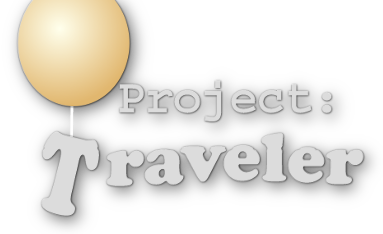| Flight Parameters | |
|---|---|
| Launch Date/Time | Sunday, 22 April, 2001 at 8:00am |
| Launch Site | East fairgrounds parking lot near Fairgrounds Pool (38º 04.6'N, 97º 54.9'W) in Hutchinson, KS |
| Estimated Burst Altitude | 90,000' MSL |
| Estimated Ascent Rate | 1000'/min |
| Capsule(s) weight | 4lb 2oz |
Flight Results
| Flight Statistics | |
|---|---|
| Launch Date/Time | Sunday, 22 April, 2001 at 8:28am |
| Launch Site | East fairgrounds parking lot near Fairgrounds Pool (38º 04.6'N, 97º 54.9'W) in Hutchinson, KS |
| Burst Altitude | 90,264ft (27,513m) MSL |
| Average Ascent Rate | 437ft/min (2.22m/s) |
| Measured Descent Rate | -Lack of data at touchdown- |
| Touchdown Site | 19 miles east of Beatrice, NE (40º 15.1'N, 96º 21.4'W) |
| Touchdown Time | Sunday, 22 April 2001 at Approx. 12:54pm |
| Recovery Time | Sunday, 22 April 2001 at Approx. 1:30pm |
| Distance Traveled | 172 miles (277km) as the crow flies |
| Total Flight Time | 4 hours 16 minutes |
| Downloads | Lat/Lon File, Log File, Flight Analysis |
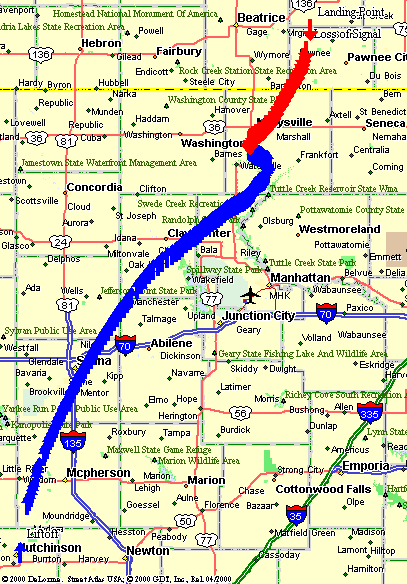
Flight Write-up
This was RCKARA's first high-altitude balloon flight and was largely an experiment. Before this balloon was built, no one from the group had ever really worked with a GPS let alone APRS before. We started basically from scratch building a flight computer and assembling the pieces to send up a GPS, some telemetry equipment, and a camera. We had a lot to learn but it all came together in the end.
After several meetings with interested amateurs, we had a good idea of what we wanted to do with this balloon and future balloons as far as payload and objectives are concerned. We knew that this was going to be a rather basic balloon and would primarily serve to test our equipment and for that reason, I have dubbed this flight 'Beta 1'.
By the end of May 2001, everything was starting to come together. The computer board was built and tested, the capsule was about ready, and most of the details had been decided on. After working through everyone's schedules for the coming weeks, we decided on Sunday morning, April 22, 2001 for its maiden flight.
The forecast wasn't looking good for the flight in the days ahead of time. The last forecast I saw on Saturday night indicated that a squall line of tornado-producing thunderstorms were going to be moving through the area that day.
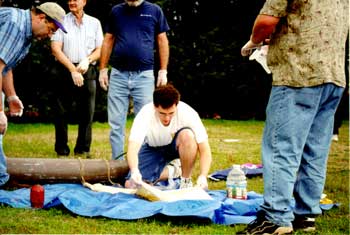
Getting the balloon ready to fill.
A Bunch of Guys and Gals on a Rainy Day
Sunday morning finally rolled around (after a night of waking up every hour dreaming that I had over slept) and the forecast of scattered showers showed to be holding true. I pulled up the weather on the Internet and the Doppler radar was showing a patch of rainless area to the southwest of Hutchinson. I received calls from a couple of the other chase members around town and Jon Riley, AJ0NR, told me that he would personally go out through the rain and retrieve the package if need be. That was all I needed to hear! Despite the 20mph surface winds, the launch was on!!!
I announced on the repeater that the launch was on and nobody chickened out. Some thought I was crazy, but none chickened out. We launched from the field just east of the fairgrounds which just happened to have a row of trees that blocked a south wind very nicely (I had that all planned out.... yep, all planned out ;-) ). The winds behind those trees were very calm - under 5mph. After seeing this, I started unloading the equipment.
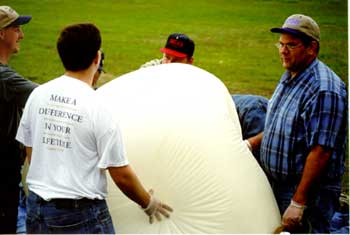
We started filling from a regulator that was going to take four hours at that rate. We soon filled directly from the bottle.
After the capsule, the helium, and all of the support equipment was in place, we started filling the balloon. This was the part that I was most nervous about. I had seen video of other groups doing this, but until the day before the launch, I had never actually had a weather balloon in my hands. Thanks to the many generous groups on the web that have shared their experiences with me, I proceeded with caution with the help of about six assistants..
I had rented a regulator with the helium tank that had a hose connected to it for attaching to the balloon. However, as I had begun to suspect, the volume gauge only goes up to 35 cubic feet per hour is in fact reasonably accurate with helium. After about 10 minutes of filling, we didn't even have enough helium in the balloon to lift itself off of the ground, let alone 7.5 pounds of lift. We did some discussing and finally disconnected the hose and the regulator and very carefully filled the balloon directly off of the bottle. About two minutes later we were done filling.
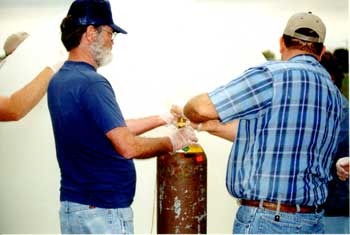
Here we had given up on the regulator and were going straight from the bottle.
Using a gallon jug filled with water to weigh 6lb 10oz (the capsule weighed 4lb 2oz plus 2.5lb of lift) we let the balloon try to lift the jug to see if we had enough helium in it. With 2.5 pounds of lift, we should have risen at about 1,000 feet per minute and reached the maximum altitude of about 90,000 feet. The balloon seemed to lift the jug just fine however we soon realized we didn't have enough helium.
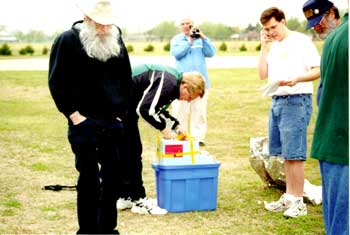
Casey is looking over the capsule one last time and I am trying to get a hold of the Hutch Tower.
We Have Liftoff!!!
With the help of Casey Swarts, we went through the checklist that was prepared to make sure we had everything running correctly. Everything looked good so I picked up the cell phone to call the Hutch Tower to let them know we were going in a few minutes. I dialed the number -- busy signal. I dialed again -- busy signal. I tried calling them probably 15 times over a 5 minute period and never could get through. I tried calling the Wichita tower but with the number I had with me, I couldn't get an answer out of them. So with the batteries a waste'n, we had to make a decision. We decided that the tower knew that we were launching about this time, we couldn't see or hear any planes, so we made the decision to launch without notifying them and continue to call them while on the road.
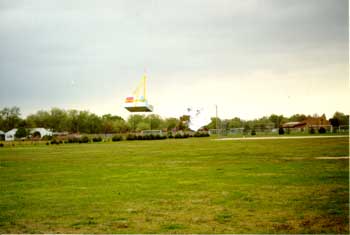
It's a little hard to see, but that's our capsule just left of center as it was scooting along the ground.
A small group of us raised the balloon into the air, then the parachute followed. I held on to the box and at 8:32am, on 22 April 2001, the RCKARA Balloon Beta 1 took flight. At first it just floated across the ground for about 20 feet and then suddenly shot skyward. There was some relief and that's when the real excitement began for the chase teams.
Casey and myself, Zack Clobes, W0ZC, took my car. Jon Riley, AJ0NR and his wife Brenda, KC0HKU, took their van. Cleyon Yowell, AD6P and co-pilot Craig Brawner, N0CAB headed off in Cleyon's car. And finally, Dwayne Gobin, KB0FJI and his wife Vivian, N0LQE turned north in their car tracking the backup transmitter signal. With the exception of Dwayne and Vivian, everyone had a laptop tied in with Street Atlas/APRS+ receiving signals. However, that didn't last long.
And Then it Happened
On our tracking station, the balloon suddenly quit moving about 10 miles north of town. That seemed like kind of a funny thing for a balloon to do. I started checking all of our equipment and we were getting a signal from the balloon but no updates on the map. We fooled with it and found that for some reason, the packets were getting scrambled in our TNC. That's no good. A quick call on the radio to Cleyon however, confirmed that the balloon was still working because he was tracking it up near McPherson. Casey and I pulled over to swap out the receiver on our setup to see if something had happened to the scanner I was using but no luck. After some tinkering, we were only able to receive about one out of every ten transmissions, and those were marginal. All kinds of errors and seldom a position or anything useful.
While we were pulled over though, Jon pulled up behind us and he said he'd had problems too. His TNC went up in smoke! Out of three fully equipped vehicles with full tracking capability, were were now down to one station being able to track the balloon. I was scared.
We kept heading north based on Cleyon's readings up through Salina. We must have been pretty excited because neither Casey or I remembered the road construction that we drove through south of Salina when we were coming home later that evening. Up near Salina, Cleyon, the only working tracking station, reported that his laptop batteries apparently hadn't taken a very good charge because he was almost dead. Now I was really scared!
A quick call on the Salina repeater yielded a ham operator (I'm sorry I have forgotten your name/callsign) who was able to receive the balloon's transmissions and gave us some position updates so Cleyon could keep his laptop in sleep mode to conserve battery power. With his help, we did realize that we weren't climbing very fast. The 1000 feet per minute that we were expecting was actually more like 500 feet per minute. That means it's going to take twice as long to go up, go up higher, and travel further. That really distressed me. It was becoming clear that we were going to be very lucky if we didn't end up in at least Nebraska looking for this thing.
Near Abilene, we decided to make a quick stop and reconfigure some equipment. By this time, Cleyon's laptop batteries were dead so Casey and I took his HT/TNC so we could track on our laptop and Jon took my TNC so he could track. This proved to be a very wise move. Back on the road, Casey realized that we were getting most updates, but certainly not all of them. Jon however, was getting 100% copy on the balloon. With plenty of battery in his back seat, he was our eyes to the sky. Our laptop wasn't in very good shape on batteries either so we kept it sleeping most of the time.
Ralph to the Rescue!
About that time, Ralph, W0RPK from Iowa popped in on 40m. Ralph and I had corresponded via email the days before and had almost decided not to carry any equipment in which he could communicate with us. We were so glad we did have HF on board because he held our hand the whole way in. He had been tracking our balloon for a while now from his home station in Iowa and was working with Mark Conner, N9XTF near Omaha Nebraska to work on predictions of a landing spot. His first calculation plotted the balloon going into the south-west corner of Iowa. That was discouraging. He told us to hold on and keep heading north. He soon came back with an updated prediction that plotted it in much closer - about 30 miles north of the Nebraska border.
Jon needed to have his kids picked up from their sitter so we used the cell phone to call home and had Scott, KC0BHE take care of that. That was it, we were all committed to coming home with a balloon capsule. We exchanged cell phone numbers with Ralph because 40m propagation was just marginal to him. He also told us that Mark Conner was on his way down to the landing site and would probably beat us to the balloon. Things were starting to look up.
Once the balloon hit about 75,000, the winds calmed down and it just hung there and we were actually able to get ahead of it for once. Thanks to Ralph and Mark's predictions, we continued north into Nebraska. Just about that time, the balloon reached 91,000 and the balloon burst. It had been climbing at 450 feet per minute and now it was suddenly dropping at somewhere around 7,500 feet per minute for the first few minutes. It was down to about 50,000 where the air is a little thicker to slow the parachute before we knew it.
With Jon still tracking the station we needed to head east about five miles. I had picked up a little handheld GPS unit to assist in the actual recovery of the balloon once it was on the ground, but this thing came in handy even before the recovery. No one else had detailed maps of southern Nebraska so I turned east on some little dirt road and the handheld GPS just plotted us across it. No one else knew were we were at, but by the descriptions that Jon was calling out, I knew we were getting really close.
Then we Lost the Signal
The balloon was under 10,000 and was only a couple miles away when we received its last packet in the air. We're still not quite sure what happened by think maybe the condensation on the circuit board killed the computer. We got back out on to the main highway and stopped to ponder the situation. No coordinates, and we weren't close enough to hear the backup transmitter, and by this time it would be back on the ground. We weren't quite sure what to do but we decided that it must either be stuck on the top of the tower across the road from us or it was down the road a couple of miles. A good look over the radio tower showed no signs of balloon impact so we continued up the road. Just then our helper, Mark Conner, chimed in on the radio. He had the same experience as us - a loss of signal at 7,000 feet in the air but figured we were in the right area. Just then, Jon heard the signal again. I plugged the coordinates of it into my GPS, drove up the highway, stopped and pointed out my window to call out on the radio that it was ".33 miles that way" according the the GPS.
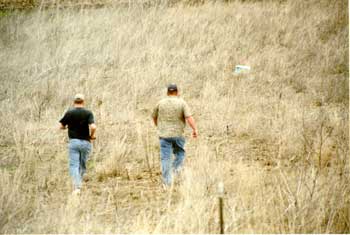
Mark and Craig are in the lead to recover the box. Jon was not far behind.
And was it ever right! We crossed a couple of barbed wire fences in a pasture and sure enough found it laying out in the open. It was unharmed and in good condition with the transmitter still beating. Mark, Jon, and Craig actually went down to pick up the capsule and brought it back. We shut it down and headed to town for lunch at Burger King.
Conclusion
It was a blast!!!! I will admit that I probably stressed out over the whole thing a little more than I should have but it was a lot of fun. We got to meet a lot of people over the months of working on this project from area clubs and groups and I got to demonstrate ham radio at its finest to a few non-hams. I think that everyone was very impressed that we had all of the support from Ralph and Mark in helping track and recover the unit. When we arrived home, I had emails from two people in Oklahoma that said they heard the balloon and had sent me some data from it.
I will be posting a list of mistakes and things to do differently soon on the website. I think we should be able to fix everything and be back up and running by early summer for the next one. I hope we can have some of the bugs worked out of the system and get even more people involved in the chase and recovery. The balloon project is a bit of a unique experience in the hobby - it appeals to all your senses. There's the hundreds of hours of research, design, building, and testing to get everything running. There's hours involved in learning software and using the laptops to track the balloon. The launch was a big ordeal requiring at least about eight people actively participating not to mention the on-lookers and camera/video people. The hours spent on the road using all of this cool technology and enjoying our hobby. Then a trek through the outdoors to retrieve the balloon and finally ending in a restaurant chowing down. It's just all-around an awesome experience.
Thanks to all of those who helped, encouraged, and supported this project. I hope to do it again soon.
Lessons Learned
- Balloon quit transmitting at 7,000 on its decent. Just before its last transmission, the transmitter remained keyed up after a series of packets. It has been theorized that condensation on the circuit board (which was witnessed when we unpacked the capsule on retrieval) had shunted the PTT line to ground thereby keeping the transmitter keyed. If this had been the case, the condensation could also have stopped the oscillator on the microprocessor and caused it not to function properly. An enamel/epoxy coating should be placed on the boards to attempt to insulate the connections from moisture on the next launch.
- Some of the packets containing the GPGGA GPS string were truncated. This is most likely a software bug. The software for the next balloon is going to be re-written from scratch using different methods for accumulating the GPS data.
- Not enough helium was put into the balloon thereby causing a slow accent rate/long travel distance. I would like to see a two-fold approach for correcting this problem on the next go-around. First, I am going to try to purchase a regulator that measure volume per unit of time that is calibrated for helium gas. This will let us time the filling and judge how much helium has been used to a reasonable amount of accuracy. Second, I am going to built a platform with a hinged pivot point that will allow us to measure the lift of the balloon, either by counter-balance or by fish scale, continuously throughout the filling process. This will help in averaging the lift measurements.
- Equipment failure in the vehicles. Zack's TNC failed to work properly in the vehicle. The only idea that I can come up with is that the unit is fairly sensitive to supply voltage (which I had witnessed a few weeks before while testing from a battery on the dining room table) and that when my car was fully loaded down with 2m mobile and HF as well as extra-long power cords, that engine noise was interfering with the TNC's operation. In the future, we need to test mobile tracking with all the equipment in place. Extra attention needs to be paid to weak-signal tracking. Other equipment problems can also be tracked down to hurried installation without thorough testing.
- Outside temperature sensor reading unreasonably high temperatures. The temperature sensor on the outside of the balloon was reading about +40 degree Celsius throughout the flight. This was certainly inaccurate. The next launch will use a 0-5 volt ready-made and calibrated sensor unit. This was probably a software bug and the new software should be correct.
- The camera failed to take all 36 exposures. On future flights, a better camera will be used that is capable of being electronically triggered, instead of mechanically triggered. Possible causes for the failure include the balsa box changing shape, warping, or becoming flexible and not causing the servo arm to push the shutter button (it doesn't take much to put it out of alignment). The other, more probable answer was that either the servo or the camera's motor froze up due to cold temperature.
- Unable to contact Hutchinson Airport Tower before launch on cell phone. In the future, Zack will sit down and study the instruction manual of the cell phone before operation so that he realizes that he needs to dial the area code even on local phone numbers.
- Laptop batteries running dead. All chase vehicles should have an DC/AC inverter that can power the laptop or a confirmed runtime of 6-8 hours on battery.
